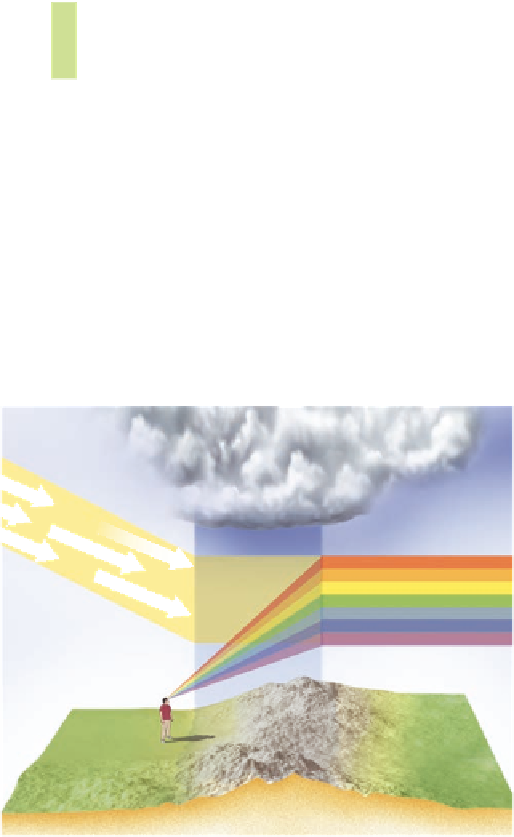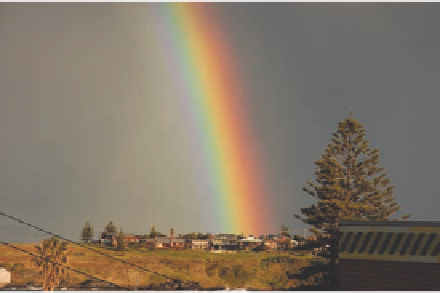Geoscience Reference
In-Depth Information
D i s c o v e r…
THE FORMATION OF RAINBOWS
In addition to producing clouds, the presence of water vapor
in the air can have a very beautiful side effect because it
is linked to the formation of rainbows. A rainbow develops
when white light from the Sun peeks through the clouds and
strikes water droplets in the air from a rainstorm. The water
droplets bend the light rays, but by a different amount for
each color of light. The result is that the white light is spread
out into bands of colors. These colors are reflected back
down toward Earth by the water droplets, at an average an-
gle of about 42°. If you are standing in the right place at the
right time, you see these colors as a rainbow.
Rainbows require bright sunlight, so you cannot see
one during the height of a rainstorm. On the other hand, a
rainbow requires the presence of water droplets in the air, so
it will disappear after the rain has gone. In other words, the
sight of a rainbow usually means that the rain is clearing out
and fair weather is ahead.
Rain clouds
White
sunlight
Rain
Rainbow
42 degrees
Water droplets in the air bend sunlight by an angle that de-
pends on the wavelength (color) of the light. We see the result
as a rainbow. Notice that red appears at the top of the rainbow
and blue at the bottom because red light is bent more than
blue light.
A rainbow near Jervis Bay, Australia.
Ozone
Ozone is a form of oxygen that has three oxygen atoms
(O
3
), rather than the two found in normal oxygen gas (O
2
). Atmo-
spheric ozone forms when gaseous chemicals react in the upper
atmosphere (Figure 4.9) with light energy. In the initial stage of
this reaction, O
2
absorbs UV energy, which causes the oxygen
molecule to split into two oxygen atoms (O + O). Subsequently,
one of the O atoms combines with an O
2
molecule to form ozone.
Ozone is naturally destroyed when it absorbs UV radiation and
splits from O
3
into O
2
+ O. The single oxygen atom can then
recombine with another O
2
molecule to form ozone. Ultimately,
O
3
, O
2
, and oxygen atoms (O) are repeatedly formed, destroyed,
and re-formed in the ozone layer in a way that absorbs UV radia-
tion each time a transformation takes place.
Ozone primarily occurs in two layers in the atmosphere:
at ground level and within the stratosphere. Although diffuse
amounts of ozone exist as high as 50 km (32 mi) above Earth,
it is most concentrated in the ozone layer between about 15 km
and 30 km (9 mi to 19 mi; see Figure 4.10). Ground-level ozone
is a form of pollution (Figure 4.11) created when nitrogen ox-
ides and organic gases emitted by automobiles and industrial
sources react. This form of ozone has been linked to cardiore-
spiratory illness and may also cause crop damage.
Human Interactions: The Ozone Hole
The greatest
concentrations of ozone are found in the
ozone layer
. This
Ozone layer
The layer of the atmosphere that contains high
concentrations of ozone, which protect the Earth from ultravio-
let (UV) radiation.




















